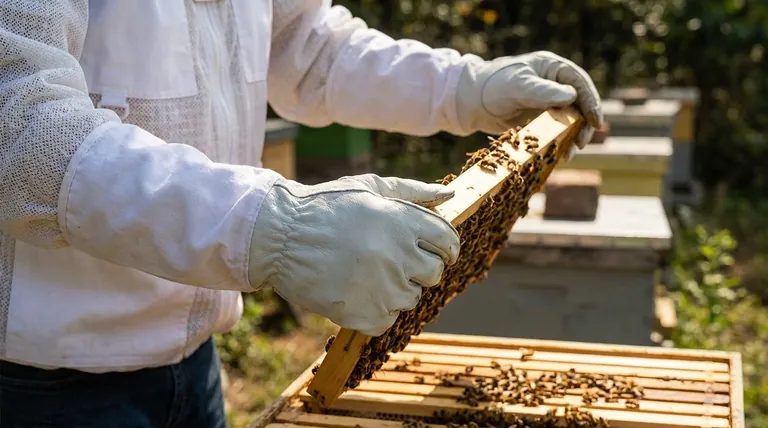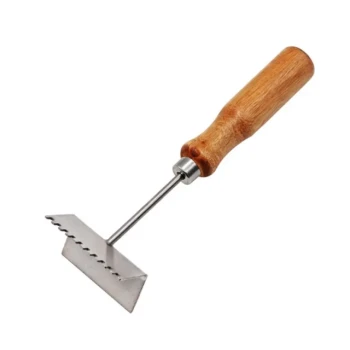The ideal fit for a beekeeping glove is a precise balance. It must be snug enough to become an extension of your hand for maximum control and protection, yet loose enough to avoid restricting movement or causing fatigue. A proper fit is the foundation of confident, calm, and safe beekeeping, directly impacting both your safety and the well-being of your bees.
A snug glove enhances your dexterity and prevents bees from crawling inside, protecting both you and the hive. Overly tight gloves compromise your safety by restricting movement and causing hand fatigue, while loose gloves create clumsy hazards that can crush bees and damage the hive.

The Case for a Snug Fit
A properly snug glove is your most important tool for interacting with the hive safely and effectively. It provides control, prevents breaches in your defenses, and protects the colony from accidental harm.
Maximizing Control and Dexterity
A glove that fits well allows you to handle delicate hive components, like frames laden with brood and honey, with necessary precision.
This snugness eliminates excess material that could otherwise get in the way, snag on equipment, or reduce your ability to feel what you're doing.
Preventing Bee Entry
One of the most common ways a beekeeper gets stung on the hand or arm is when a bee crawls inside a loose-fitting glove.
A snug fit, especially at the cuff, creates a secure seal. This barrier is often reinforced by layering your beesuit or jacket over the glove's extended gauntlet, which typically reaches the elbow.
Protecting the Hive
Excess material from a loose glove makes your movements clumsy. This significantly increases the risk of accidentally rolling or crushing bees between frames.
A well-fitting glove minimizes this risk, allowing you to work gently and with more awareness, which keeps the colony calm.
The Dangers of an Overly Tight Fit
While a loose glove is clumsy, a tight glove is actively detrimental. It introduces physical limitations that make beekeeping uncomfortable and less safe.
Compromised Blood Circulation
Gloves that are too tight will restrict blood flow to your hands and fingers.
This quickly leads to discomfort, numbness, and fatigue, making it difficult to perform tasks for any length of time.
Restricted Movement and Flexibility
Beekeeping requires a surprising amount of fine motor skill. Tight gloves act like a straightjacket for your hands, severely limiting your flexibility.
This restriction makes it harder to grip tools, lift frames, or perform delicate operations, increasing the chance of mistakes.
Understanding the Trade-offs in Glove Materials
The material of the glove directly influences its fit, flexibility, and level of protection. Choosing the right material is as important as choosing the right size.
Thick Leather: Maximum Protection, Less Dexterity
Traditional leather gloves are extremely durable and offer the highest level of sting resistance, which builds confidence for beginners.
However, they are often stiff and bulky, which can reduce your sensitivity and make intricate tasks more challenging.
Goatskin & Nitrile-Coated: The Balanced Approach
Goatskin is a popular material because it offers an excellent balance between sting protection and flexibility.
Similarly, nitrile-coated gloves provide good dexterity and grip while still offering reliable protection, making them a versatile choice for many beekeepers.
Canvas: High Dexterity, Lower Protection
Canvas gloves are lightweight and flexible, making them suitable for tasks that require a high degree of precision.
Their main drawback is that they offer less resistance to stings compared to leather or goatskin.
Making the Right Choice for Your Goal
Ultimately, the best glove fit depends on your comfort level and the specific task at hand. Always try on gloves before buying to ensure they meet your needs.
- If your primary focus is maximum safety during routine inspections: Choose durable goatskin or leather gloves that fit snugly around the fingers and wrist without feeling constrictive.
- If your primary focus is delicate tasks like queen rearing: Opt for thinner, more flexible goatskin or nitrile-coated gloves where a precise, snug fit is crucial for dexterity.
- If you are a new beekeeper: Prioritize a comfortable, snug fit in a goatskin glove that inspires confidence, and practice handling equipment to become accustomed to the feel.
Selecting the right glove fit is a fundamental decision that directly impacts the safety and well-being of both you and your bees.
Summary Table:
| Fit Type | Benefits | Risks |
|---|---|---|
| Snug Fit | Maximizes control, prevents bee entry, protects the hive | None when properly fitted |
| Tight Fit | - | Restricts blood flow, causes fatigue, limits movement |
| Loose Fit | - | Increases sting risk, clumsy handling, can crush bees |
Equip your apiary with confidence. HONESTBEE supplies high-quality beekeeping gloves and equipment designed for the demanding needs of commercial apiaries and distributors. Our wholesale-focused operations ensure you get the durable, well-fitting gear that protects your investment and your bees. Contact us today to discuss your needs and get a quote.
Visual Guide

Related Products
- Vented Beekeeping Jacket with Hood and Veil for Beekeepers
- 3 Layer Mesh Vented Sting Proof Beekeeping Suit with Hat and Veil
- Cotton Beekeeping Suit and Round Hat with Veil Bee Keeper Protective Gear
- Yellow Plastic Bucket Pail Perch for Beekeeping
- Heavy-Duty Stainless Steel Clip-On Frame Perch
People Also Ask
- What features should be considered for sting protection in a beekeeping suit? Ensure Total Safety and Comfort
- How does a ventilated suit balance sting protection and comfort? The Science of Cool, Safe Beekeeping
- What should be considered when purchasing a ventilated bee suit? Ensure Maximum Safety and Comfort
- What should be considered regarding the color of beekeeping clothing? Ensure Your Safety and Keep Bees Calm
- Why is it important to close all zips and fasten buttons before washing a beekeeping suit? Protect Your Suit & Your Safety



















